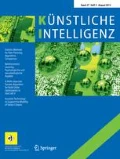Abstract
With the computational power of modern smartphones constantly increasing, resource intensive applications are becoming feasible to an ever growing extent. In this paper, we report on a research project recently started. Its aim is to develop an application for smartphones that combines pedestrian and public transport navigation including the computation of routes consisting of pedestrian routes and public transport trips and intuitive user guidance at any time of the trip. In particular, we focus on intuitive user guidance based on (LMs) in the surroundings of the user. For this reason, we use collaborative approaches to collect LMs and data about them.






Similar content being viewed by others
Notes
A very similar clustering was calculated for the Tourist Guide group, which has been omitted here due to space limitations.
Lynch’s term landmark [15] and salient objects are used interchangeably throughout this work.
[2] applies minor changes to the definition of the concepts, but the basic ideas remain.
References
Testbericht: 7 Navi-Apps für Smartphones im Test. online (2012). http://www.connect.de/testbericht/7-navi-apps-fuer-smartphones-im-test-1238322.html#. Last access on Nov 11th, 2012
Caduff D, Timpf S (2008) On the assessment of landmark salience for human navigation. Cogn Process 9(4):249–267
Chaouali M (2008) Personalisierte Landmarken – Einfluss der Ortskenntnis auf die Auswahl. Master’s thesis, Institut für Kartographie und Geoinformatik, Universität Hannover
Chittaro L, Burigat S (2005) Augmenting audio messages with visual directions in mobile guides: an evaluation of three approaches. In: Proceedings of the 7th international conference on human computer interaction with mobile devices & services, MobileHCI ’05. ACM, New York, pp 107–114
Google Inc.: Google maps (2012). https://play.google.com/store/apps/details?id=com.google.android.apps.maps&feature=nav_result#?t=W251bGwsMSwyLDNd. Last access on Feb 12th, 2013
Ishikawa T, Fujiwara H, Imai O, Okabe A (2008) Wayfinding with a gps-based mobile navigation system: a comparison with maps and direct experience. J Environ Psychol 28(1):74–82
Ishikawa T, Nakamura U (2012) Landmark selection in the environment: relationships with object characteristics and sense of direction. Spat Cogn Comput 12(1):1–22
Kato Y, Takeuchi Y (2003) Individual differences in wayfinding strategies. J Environ Psychol 23(2):171–188
Kattenbeck M, Brockelmann M, Hammwöhner R, Jackermeier R, Ludwig B (2013) Vermessungsdaten - OpenStreetMap - In-Situ-Experimente. Die Datengrundlage von URWalking. In: Proceedings of the 13th international symposium of information science, Potsdam, March 19–23, 2013
Klippel A, Winter S (2005) Structural salience of landmarks for route directions. In: Proceedings of the 2005 international conference on spatial information theory. Springer, Berlin, pp 347–362
Kluge M (2009) Fußgängernavigation – Reality View: Entwicklung und Implementierung eines auf erweiterter Realität basierenden Navigationssystems für Fußgänger auf mobilen Geräten. Vermess Brandenbg 2:60–69
Köpke J (2007) Personalisierte Landmarken. Master’s thesis, Institut für Kartographie und Geoinformatik, Universität Hannover
Kreuzpointner L, Lukesch H (2013) (LPS-2). Leistungsprüfsystem 2. Hogrefe, Göttingen
Lübke C (2004) Extraktion von Landmarken aus ATKIS-Daten. Master’s thesis, Institut für Kartographie und Geoinformatik, Universität Hannover
Lynch K (1960) The image of the city. MIT Press, Cambridge
Muenzer S, Hoelscher C (2011) Development and validation of a self-report measure of environmental spatial strategies. Diagnostica 57(3):111–125
Pielot M, Boll S (2010) In fifty metres turn left: why turn by turn instructions fail pedestrians. In: Proceedings of HaptiMap, workshop at MobileHCI. ACM, New York, pp 26–28
Raubal M, Winter S (2002) Enriching wayfinding instructions with local landmarks. In: Egenhofer M, Mark D (eds) Geographic information science. Lecture notes in computer science, vol 2478. Springer, Berlin, pp 243–259
Rümelin S, Rukzio E, Hardy R (2011) Naviradar: a novel tactile information display for pedestrian navigation. In: Proceedings of the 24th annual ACM symposium on user interface software and technology, UIST ’11. ACM, New York, pp 293–302
Stark A, Riebeck M, Kawalek J (2007) How to design an advanced pedestrian navigation system: field trial results. In: 4th IEEE workshop on intelligent data acquisition and advanced computing systems: technology and applications. IDAACS 2007, pp 690–694
WiFiSLAM Inc.: Wifislam (2013). http://www.wifislam.com/#/home. Last access Feb 13th, 2013
Winter S (2003) Route adaptive selection of salient features. In: Kuhn W, Worboys M, Timpf S (eds) Spatial information theory. Foundations of geographic information science. Lecture notes in computer science, vol 2825. Springer, Berlin, pp 349–361
Winter S, Raubal M, Nothegger C (2004) Focalizing measures of salience for wayfinding. In: Meng L, Reichenbacher ZAT (eds) Map-based mobile services: theories, methods, and design implementations, Springer geosciences, pp 127–142
Small worlds: stadtführung regensburg (2013). https://play.google.com/store/apps/details?id=de.smallworlds.cityguide&feature=search_result#?t=W251bGwsMSwxLDEsImRlLnNtYWxsd29ybGRzLmNpdHlndWlkZSJd. Last access on Feb 12th, 2013
Acknowledgements
NADINE is funded by the German Federal Ministry of Economics and Technology (BMWIi) under grant no. 19 P 12009 F.
Author information
Authors and Affiliations
Corresponding author
Rights and permissions
About this article
Cite this article
Ludwig, B., Bienk, S., Kattenbeck, M. et al. Do You Recognize That Building’s Façade?. Künstl Intell 27, 241–246 (2013). https://doi.org/10.1007/s13218-013-0253-4
Published:
Issue Date:
DOI: https://doi.org/10.1007/s13218-013-0253-4




